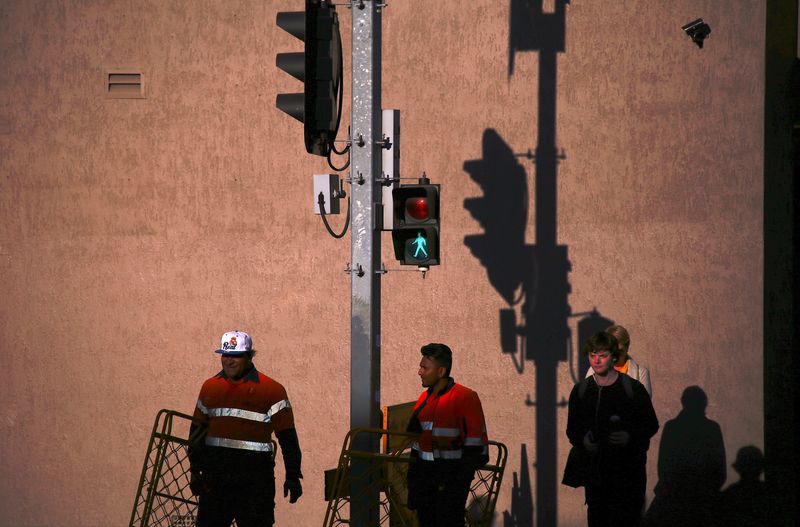Australia Q2 wage gains underwhelm, argue against further hikes
2023.08.15 00:19

© Reuters. FILE PHOTO: Workers carry barriers as they wait to cross a street at a set of traffic lights with pedestrians at sunset in central Newcastle, located north of Sydney, Australia, August 13, 2018. REUTERS/David Gray/File Photo
By Stella Qiu
SYDNEY (Reuters) -Australian wage growth held steady in the June quarter while the pace of annual pay awards unexpectedly slowed, raising hopes that inflationary pressures are weakening and building the case against further increases in interest rates.
Coupled with the release of dovish minutes from the July policy meeting , investors doubled down on bets that the Reserve Bank of Australia (RBA) would keep rates steady for a third straight month in September with a 91% probability, compared with 85% before.
The Australian dollar hit a session low of $0.6463 before stabilising at $0.6489, while three-year bond futures pared earlier losses to be down just 2 ticks at 96.07.
The data released by the Australian Bureau of Statistics on Tuesday showed the wage price index (WPI) rose 0.8% in the June quarter from the previous quarter, against forecasts of a 0.9% increase.
Annual pay growth eased a little to 3.6% from a decade high of 3.7% in the previous quarter, breaking an accelerating trend seen since the March quarter 2021. That compared with forecasts of 3.7% growth.
“Wage growth has been stuck at 0.8% q/q for the past three quarters – a somewhat surprisingly slow pace given the very low level of the unemployment rate,” said Sean Langcake, head of macroeconomic forecasting for Oxford Economics Australia.
Despite higher interest rates, Australia’s jobless rate is hovering near 50-year low of 3.5% and the economy is adding more jobs than expected. However, wages are still lagging behind inflation in a squeeze on real incomes.
The RBA now sees a credible path where inflation could be restrained with interest rates at their current level, minutes showed on Tuesday.
The path involves annual wage growth peaking at 4.1% by the end of the year before easing back to 3.6% by end-2025, according to the bank’s latest forecasts.
However, risk is wages in the third quarter could spike higher after a large mandated increase in the minimum and award wages, which could prompt the RBA to hike rates one last time by the end of the year. Currently, investors put that chance at above 50%.
Andrew Boak, an economist at Goldman Sachs (NYSE:), said the second quarter wages data are not particularly informative, adding the the RBA is likely to give more signficance to the third quarter WPI report due in November and broader measures of nominal unit labour costs in the June quarter National Accounts, due on Sept. 6.
The ABS data showed wages in the public sector picked up to an annual rise of 3.1% while growth in private sector wages increased 3.8%.








